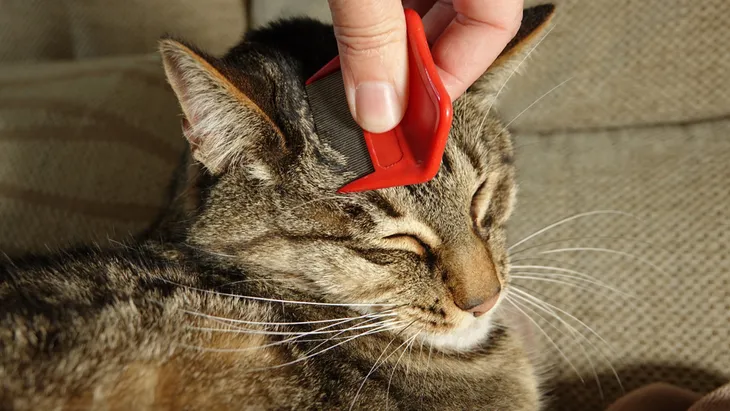- Skin allergies often cause intense itchiness, resulting in frequent scratching and overgrooming.
- Left untreated, your cat may develop open sores, ulcers, and hair loss.
- There are three common triggers for skin allergies in cats including food allergies, flea-related allergies, and environmental allergies.
- Treatment will depend on which trigger is causing their allergies.
Cats have a natural instinct to scratch and groom. But when you notice your cat scratching more than usual or overgrooming it may be a sign that something is wrong. Just like humans and dogs, cats can develop skin allergies too.
If left untreated, your cat can become uncomfortable and develop painful symptoms like lesions and even hair loss. So, it’s important to get informed and know the signs of a skin allergy so you can get your cat the treatment it needs. Here’s what you need to know about skin allergies in cats!
Common Signs of Skin Allergies in Cats
Skin allergies often cause intense itchiness. This usually results in frequent scratching and overgrooming. Over time, this can lead to open sores, ulcers, and scabs. Your cat may also develop hair loss from intense scratching and overgrooming.
Skin allergies can also cause infections, such as ear infections. So, be on the lookout for debris in their ears. Other signs of an ear infection include shaking their head or scratching their ears often. If your cat is in pain, their mood may change, so it’s important to also be on the lookout for behavioral changes.
What Causes Skin Allergies in Cats?
Skin allergies develop when something in your cat’s environment triggers an excessive immune response. PetMD explains, “When your cat has an allergy, their immune system thinks that a benign protein is a virus or parasite trying to attack it, which causes inflammation.”
The source says there are three common triggers for skin allergies in cats including food allergies, flea-related allergies, and environmental allergies. Your veterinarian will need to determine which trigger is causing their allergies and then treat the culprit. Let’s take a look at how these triggers can affect your cat next.
Food Allergies
Just like humans, cats can develop allergies to certain foods too. Petplan explains when a cat has an allergy to a certain food they typically develop gastrointestinal upset as well as skin irritation. It usually develops by the time your cat is 5-years old.
PetMD points out that cats are usually allergic to the protein in their food, not the grain, meaning that ingredients like wheat and corn aren’t usually a problem for felines. Instead, the common food allergies in cats are chicken, fish, and beef.
Flea-Related Allergies
Cats can be allergic to fleas, known as flea allergy dermatitis. It’s caused by a reaction to the flea’s bite, particularly their saliva. Petplan says, “Even a single flea bite can be enough to cause a severe reaction in affected cats, which can lead to intense itching and leave patches of raw skin.”
Common signs of fleas are intense scratching, chewing, and biting at the legs, tail, and hind end. Your cat may also develop sores and skin damage. Fleas can live anywhere making both indoor and outdoor cats susceptible to them. If you don’t have your cat on flea prevention now, it might be time to discuss that option with your vet.
Environmental Allergies
Cats can also develop environmental allergies, also known as atopic dermatitis. Common triggers include pollen, mold, dust, and other airborne allergens. Although rare, Petplan says cats can sometimes even be allergic to household cleaning sprays, air fresheners, and some fabrics, such as wool.
When the seasons change, be on the lookout for skin allergy symptoms in your cat. Allergy symptoms at the start or end of a new season may indicate your cat has seasonal allergies.
Diagnosing and Treating Skin Allergies in Cats
In some cases, your cat’s symptoms might be from other skin problems like ringworm fungus or bacterial infections. Your vet will need to rule out all other possible causes when diagnosing skin allergies.
To diagnose what trigger is causing your cat’s skin allergies your vet will have to perform a variety of tests. You may also need to visit your vet every couple of weeks until your cat’s symptoms have improved. Let’s take a look at some of the possible ways your vet may test for allergies.
Testing for Food Allergies
VCA Animal Hospital says the radioallergosorbent test (or RAST test) can help your vet diagnose a food allergy. This is a blood test that looks for allergies to certain antigens.
If your cat has a food allergy the results will show which foods are triggering your cat’s allergies. From there, your vet will determine the best treatment plan to help improve your cat’s symptoms.
PetMD also notes that your vet may diagnose a food allergy through a novel protein diet or a hypoallergenic diet. However, this process can take a few months to determine which foods are triggering the symptoms.
Signs of Fleas
You can check for signs of fleas at home by combing your cat. Examine the comb and look for fleas, which are small and brown. You should also be on the lookout for flea dirt (feces) — it looks similar to black pepper or small grains of sand. The Animal Hospital of Clemmons says the feces will turn red when wet. An easy way to test this is to apply a damp paper towel to the area.
PetMD points out that since cats tend to overgroom, it’s possible that they’ll remove all (or most) of the fleas. If your cat is still scratching and you can’t find signs of any fleas, your vet can administer a skin test to check for flea allergies, says the source.
Treatment: Reducing Symptoms
Once your vet has determined your cat has skin allergies, they’ll decide the best course of treatment. The goal of treatment is to reduce the symptoms and help your cat get better. One of the first steps is to help relieve itchy and inflamed skin.
Your vet may recommend bathing your cat. If your cat doesn’t like baths, applying a dry shampoo (designed for cats) may be effective. Your vet may also prescribe a corticosteroid to help their itchy skin. The next step will be treating the underlying trigger that is causing the allergic reaction. Let’s take a look at those approaches next.
Treating Food Allergies
If food allergies are causing the symptoms, your vet will likely recommend a low-allergen or limited-ingredient diet. A hypoallergenic diet consists of protein sources that are “broken down into small molecular pieces so that the body can no longer recognize it as a protein,” explains PetMD. As a result, this prevents your cat’s immune system from recognizing it as an allergen.
It’s important to work closely with your vet to determine the best diet for your cat. After adjusting their diet, continue to monitor their symptoms and report any allergy flares to your vet.
Treating Flea Allergies
According to Fetchy by WebMD, a female flea can lay up to 50 eggs per day. This can make getting rid of them a challenge. You’ll need to treat your cat and your home to get rid of them for good.
Start by combing your cat with a fine-toothed flea metal comb several times per day. This will help take off all the adult fleas. The source recommends dipping the comb in a mixture of hot water and liquid dish detergent to destroy the fleas. Then use a spot-on treatment provided by your vet.
To remove fleas from your home you’ll need to vacuum every day. Be sure to clean the carpets, furniture, and cracks where eggs can hatch. If your vacuum has a bag, be sure to throw it away or if it has a canister, be sure to wash it with hot soapy water after each vacuum. Finally, the source says you’ll need to wash all bedding, sofa covers and fabrics your cat has touched at least once a week. Be sure to use hot water to destroy the fleas. Finally, if your cat isn’t already on flea prevention medication your vet will likely recommend it.
Treating Environmental Allergies
While you can’t always control environmental allergies, like lowering the pollen count, there are treatments available to help your cat be more comfortable. Some cats may need to take medication regularly or during flare-ups, depending on the severity of their symptoms.
Bond Vet also says desensitization therapy may also be an option. This involves weekly injections that contain small amounts of things your cat is allergic to. Over time, your cat builds up a tolerance to the allergen.
Other ways you can help reduce environmental allergies is by keeping your cat indoors and closing the windows, especially when the pollen count is high. It’s also important to regularly clean your home and change air filters to keep dust and mold at bay.















